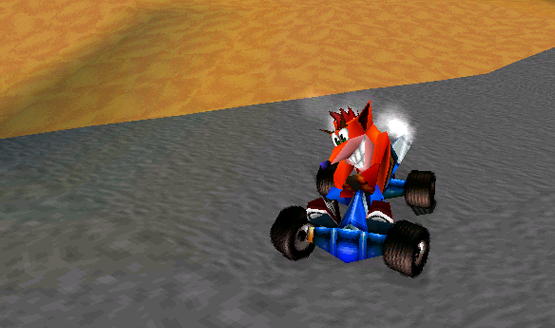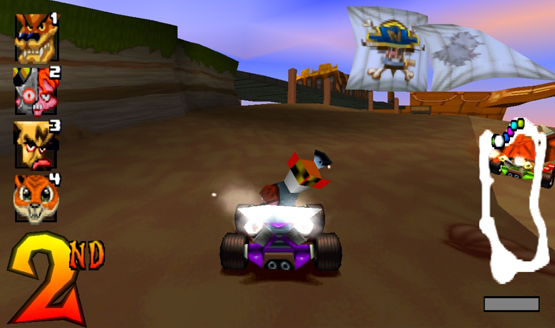Crash Bandicoot has returned with authority in 2017, reminding hundreds of thousands of players of why they begged mom and dad, saved up, and/or took those odd jobs for a PlayStation in the first place. The N. Sane Trilogy keeps all of Crash’s original journeys almost entirely intact for a rich bundle of platforming adventure. That said, the success of the N. Sane Trilogy has many of us pining for the return another classic Crash Bandicoot game: Crash Team Racing.
In the late 1990s, as Sony fiercely competed in the console market against Nintendo with Crash Bandicoot leading the way, they went through a period of attempting to prove that anything Mario could do, Crash could do better. The first of a few spinoffs to come was Crash Team Racing. At the time, many companies were invested in copying the Mario Kart formula. However, CTR was one of the original kart games to come from outside of Japan and prove that other companies could pull off a kart racer with just as much bravado as Nintendo. It not only put its own slew of Crash series all-star characters behind the wheel, but presented smart and interesting tracks full of cool tricks, gimmicks, and scenery.
Sony and Naughty Dog could have cashed in on simply producing a mediocre kart racer alongside the likes of other copy cats of the time, such as Acclaim’s South Park Rally, but they actually took some of the best of aspects of the genre, and kicked them up a notch. Crash Team Racing contains all of the similar aspects one would expect of a kart game. Characters featured a small, medium, or large build that determined speed, handling, and acceleration, and weapons were your standard offering of straight-shooting and player-seeking launchables, land mine traps, and kart power-ups. That said it was the fine-tuning and refinement of these mechanics that made CTR a thing all its own.

Diddy Kong Racing was one of the first kart games to provide a pickup that would increase player speed in the form of bananas, but Crash Team Racing upped the ante by also applying this boost to weapons. Wumpa fruit was spread throughout tracks and collecting enough of it not only allowed players to gain speed, but also upgrade to powerful versions of whatever weapon they were packing. TNT crates on a timer became instantly exploding nitro crates while powered-up missiles would fly faster and more accurate after your foes. Those who could control the fruit could become multi-faceted threats of speed and weaponry on the courses of Crash Team Racing.
Powerslides and drifting also took a notable upgrade in CTR. Drifting around turns has almost always been a simple way to get a small boost since Mario Kart 64 in 1996. However, Crash Team Racing was the first to explore the concept of the powered-up boost. Drifting around corners built up a boost meter and toggling a boost just before a catastrophic spin-out would allow players to score a better version of the regular boost, making drifting a special exercise timing and precision. It wasn’t until Mario Kart Double Dash in 2003 that the multi-tiered boost of the powerslide became a standard feature in the Mario Kart series.
Another long lost feature of kart games are Adventure Modes. Diddy Kong Racing and Crash Team Racing are two of the only kart racers to feature a single player story mode in which the player can challenge their way through all tracks, take on boss characters, unlock cool collectibles and characters, and enjoy some semblance of context on the way as to why your favorite characters suddenly decided to become motorists. Crash Team Racing’s story mode isn’t poetry in motion, but it did wonders to offer the game some extra playability when friends weren’t around to challenge in the multiplayer features.

All of this put together was enough to for Crash Team Racing to hit it big in sales 1999. The game has sold a little under 4.8 million units worldwide as of June 24, 2017, according to VGChartz. It was good enough to see a platinum re-release on the PlayStation and spawn two sequels. Why does this matter now? Because of the N. Sane Trilogy of course! The HD remake of the original Crash Bandicoot trilogy has topped video game sales lists for over a month since its release and enjoyed the number one spot on the PlayStation 4 for even longer. Vicarious Visions has brought Sony’s mascot back in an undeniable way and given him new life on modern systems.
That’s not all. The love is still alive for kart racers as well. Just look at the release of Mario Kart 8 Deluxe on the Nintendo Switch earlier in 2017. Despite simply being an upgraded port from the previous Wii U launch, Mario Kart 8 Deluxe saw an instantly successful launch, crossing one million units within three days of its release, according to an article on Mashable. The love of a good kart racing game is alive and well, and with Crash Bandicoot having made his triumphant return, the possibility for a Crash Team Racing return doesn’t just look plausible – It looks like the logical next step.
On its own, Crash Team Racing was a solid racer that offered a lot to single players and multiplayer parties alike. It proved that strong kart racers could be made outside of Nintendo’s license and has a lot to offer players even in its original form. Vicarious Visions brought Crash back with the N. Sane Trilogy, but they also know their way around a Crash kart game. They handled the sequel, Crash Nitro Kart. With the same level of dedication they gave the N. Sane Trilogy, Vicarious Visions has the tools and experience they need to bring Crash Team Racing back with the same level of polish and refinement. It just remains to be seen if Activision and Vicarious are willing to strap into the karts for one more action-packed ride.





